Ostseeküsten-Radweg - Entlang traumhafter Strände
Immer kräftig in die Pedale getreten und vorbei an traumhaften Stränden, alten Hansestädten und originalgetreuen Fischerdörfern führt der beliebte Ostseeküsten-Radfernweg Sie mitten durch Vorpommern ans Meer.
Die rauschenden Wellen, der weite Horizont und die puderweichen Badestrände der Ostseeküsten begleiten die Radwanderer auf dem Weg durch die norddeutschen Hansestädte, kleinen Fischerdörfer, Wiesen und Wälder.
Alles auf einen Blick
Mehr Infos zu buchbaren Ostsee-Radtouren
✓ Länge der Tour: 670 km
✓ Etappen: 15 Tage
✓ Bahnanbindung: Lübeck-Travemünde, Seebad Ahlbeck, Rostock -Warnemünde, Stralsund
✓ Sehenswert: UNESCO Welterbestädte Wismar und Stralsund, Rügener Kreidefelsen, Usedomer Bäderarchitektur in Zinnowitz und den Kaiserbädern
An den Toren der Lübecker Marzipanstadt beginnt die Radtour durch die verträumte Hügellandschaft des Klützer Winkels bis zur UNESCO-Welterbe-Stadt Wismar. Entlang kilometerlanger Traumstrände und wilder Steilküsten führt der Weg von Ostseebad zu Ostseebad. Auf dem Steilufer geht es in das Seebad Warnemünde. Am anderen Ufer der Warnow beginnt die Rostocker Heide, ein riesiges Waldgebiet, das die Ostseebäder Markgrafenheide und Graal-Müritz einrahmt. Mit bunten Kapitänshäusern und urigen Zeesbooten stimmt Wustrow auf die wildromantische Halbinsel Fischland-Darß-Zingst ein. Ein Höhepunkt ist die ehemalige Künstlerkolonie Ahrenshoop, deren reetgedeckte Häuser sich in die sanfte Dünenlandschaft schmiegen. Durch den Nationalpark Vorpommersche Boddenlandschaft folgen die Pedalritter dem Weg bis nach Rügen, der größten Insel Deutschlands und ein von der Natur geschaffenes Meisterwerk. Einmal rund um die Insel führt die Route weiter am wild-romantischen Kap Arkona, dem sagenumwobenen Kreidestuhl und den Feuersteinfeldern bei Sassnitz vorbei. Auf dem Weg liegen die Ostseebäder Binz, Sellin und Göhren, in denen sich ein Blick auf die eleganten Villen der Bäderarchitektur lohnt. Die gigantischen Kirchen der Universitäts- und Hansestadt Greifswald begrüßen ihre Gäste aus der Ferne. Vom wunderschönen Marktplatz der Stadt ist es nicht mehr weit bis zum Peenestrom und in Wolgast öffnen sich schon die Tore zur Sonneninsel Usedom. Die letzten Kilometer führen entlang verträumter Fischerdörfer und grüner Buchten bis an die polnische Grenze.
Sehenswertes an der Ostseeküste - Radeln mitten durch Vorpommern bis ans Meer
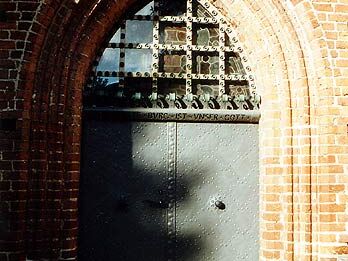
Dorfkirche Brandshagen
Die Kirche zu Brandshagen - eine Stiftung des Rügenfürsten Borante von Putbus - zählt zu den schönsten und größten Dorfkirchen in Norddeutschland.
Erbaut von den Zisterzienser-Mönchen wird sie 1249 erstmals urkundlich erwähnt. Aus dieser Zeit stammen der Chor, die Ostwand des Langhauses und die Sakristei; Schiff und Turm kamen Anfang des 14. Jahrhunderts hinzu. Die Kirche verfügt über eine reiche Innenausstattung, u. a. Fresken aus dem 13./14. Jahrhundert, eine Kalksteintaufe (13. Jahrhundert), ein Triumphkreuz (15. Jahrhundert) sowie ein Barockaltar aus der Werkstatt von Max Broder, Stralsund (1706). Die Dorfkirche wird auch Marienkirche genannt.
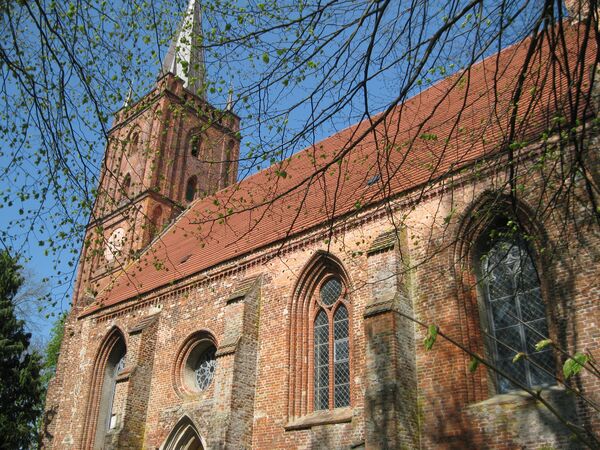
Kirche Gristow
Die Dorfkirche Gristow in Vorpommern stammt aus dem 13. Jahrhundert.
Der Baubeginn der Dorfkirche Gristow erfolgte etwa im Jahr 1280. Ursprünglich besaß die Kirche einen Holzkirchturm, der jedoch um 1690 aufgrund von Bauschäden abgerissen wurde und durch einen neuen freistehenden Glockenturm ersetzt wurde. Sehenswert im Inneren des schlichten Kirchenbaus ist die Buchholz-Orgel (um 1820). Vom Kirchturm aus kann man einen herrlichen Blick auf die Inseln Rügen und Riems, Ruden und Oie und auf die Boddenlandschaft genießen.
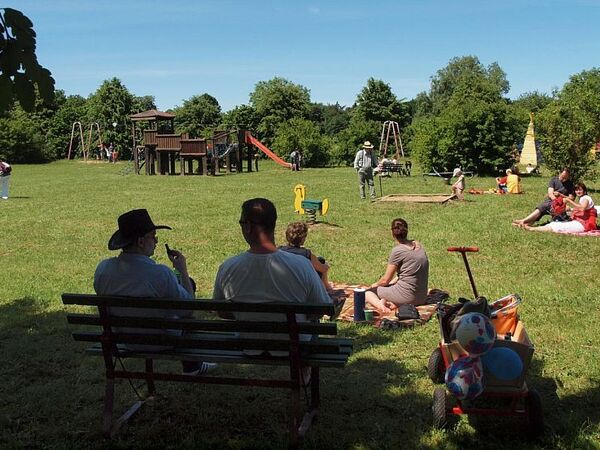
Natur Erlebnis Park Gristow
Naturbelassene Wanderwege, viele Rast- und Spielplätze und verschiedene Aussichtspunkte, die den Blick über weite Wiesen und die Gristower Wieck am Greifswalder Bodden erlauben, laden zu Spaziergängen und zu Picknicks ein. Im Streichelgehege und beim Ponyreiten können besonders Kinder hautnah Kontakt zu unseren Vierbeinern aufnehmen.
Der Park liegt direkt an der B105 zwischen Greifswald und Stralsund und bietet seinen Besuchern Erholung und Entspannung durch seine landschaftliche Vielfalt des ca. 70 Hektar großen Areals.
Rund 300 Tiere haben im Park in großzügigen Freigehegen ein Zuhause. Man begegnet den unterschiedlichsten Haustierrassen von A wie Auerochse bis Z wie Ziege. Auch viele Kleintiere wie Sittiche, Kaninchen, Meerschweinchen, Vögel usw. können hier beobachtet werden. Aber nicht nur schöne Landschaft und Tiere erfreuen hier Jung und Alt. Auch Streichelgehege, Abenteuerspielplätze mit Aussichtsturm, Seilschaukel, Klettergerüsten, ein Verkehrsgarten. Kutschfahrten und Hüpfburg (bei Festen) sorgen für Erlebnis, Spiel und Spaß. Kindergeburtstage sind für die Kleinen ein Highlight in unserem Park. Schatzsuche, Kinderspiele werden bei rechtzeitiger Anmeldung durch Parkmitarbeiter organisiert.
Es steht ein großer Saal für Ihre Feierlichkeiten zur Verfügung und Sie haben die Möglichkeit Grillplätze im Park zu mieten. Ganzjährig gibt es die Möglichkeit in unserer Beherbergungsstätte zu übernachten.
Sie würden sehr gern angeln? Ein Ruderboot ist im Zusammenhang mit einer Übernachtung zumietbar.
Weiterhin werden in der Saison Parkfeste angeboten, die bereits zur Tradition geworden sind.
Ein Besuch lohnt sich zu jeder Jahreszeit.
Ihre vierbeinigen Freunde sind ebenfalls herzlichst willkommen, sie sollten aber angeleint sein.
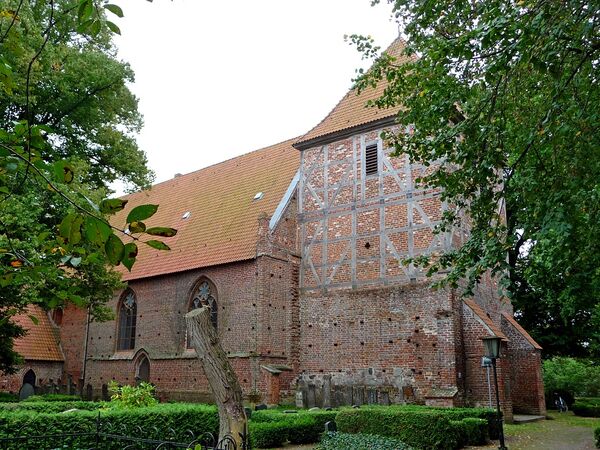
Fachwerkkirche Neuenkirchen
Die Fachwerkkirche Neuenkirchen stammt aus dem Mittelalter.
Die im 14. Jahrhundert errichtete Pfarrkirche wurde unter dem Patronat des Klosters Hilda in Eldena erbaut. Sehenswert sind mittelalterliche Grabplatten und Reste der Wand- und Gewölbeausmalung mit plattdeutschen Minuskelinschriften, die Orgel (1836) und Glasfenster am Ostgiebel des Kirchenbaus. Besichtigungswünsche bitte im Pfarramt anmelden.
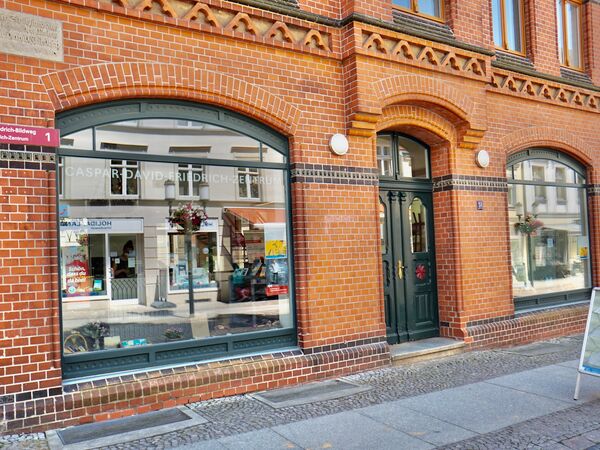
Caspar David Friedrich Center
The Caspar-David-Friedrich-Zentrum, opened in 2004 in the historic Seifensiederei and expanded in 2011 to include the entire former residential and commercial building of the Friedrich family, commemorates the great painter and greatest son of the city of Greifswald. It is also a museum, documentation and research center. Caspar David Friedrich was born here on September 5, 1774.
Visitors can see their father's old soap-making workshop, the family cabinet with the family tree, the Rügen and Eldena rooms with famous motifs from Friedrich's work and the Caspar David Friedrich Gallery. The tour offers comprehensive information on Friedrich's origins, career and creative style as well as on the history of the Friedrich family and their home and business premises, which is also the subject of a long-term research project by the Caspar David Friedrich Society. Changing exhibitions of contemporary art in the Caspar David Friedrich Gallery bear witness to the enduring fascination and impact of Friedrich's work and historical Romanticism.
Thanks to its location in the heart of Greifswald's old town, the center is a particularly attractive destination for anyone who wants to follow in the artist's footsteps in his hometown. In the immediate vicinity is St. Nikolai Cathedral, where Caspar David Friedrich was baptized, and it is only a few minutes' walk to the Pomeranian State Museum with its original Friedrich paintings.
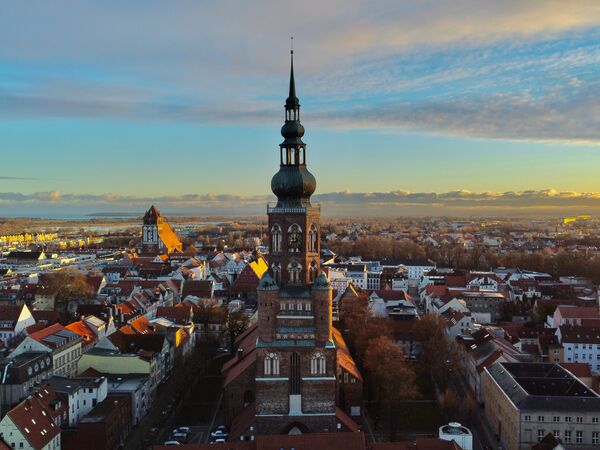
St. Nikolai Cathedral Greifswald
Greifswald Cathedral is one of the most beautiful sacred buildings in northern Germany. With its 100 m high tower, it towers over the Hanseatic city of Greifswald. From its tower gallery, you have an impressive view as far as the island of Rügen.
The slender baroque onion dome with two lanterns replaced the Gothic spire in 1652. The University of Greifswald was opened in St. Nikolai in 1456. Today it is the venue for the Greifswald Bach Week.
Protestant cathedral, first mentioned in a document in 1280, nine-and-a-half bay brick basilica with a choir closed on three sides, chapel extension and sacristy on the north side, 1st half of the 15th century incorporating the predecessor building of a five-bay, three-aisled brick hall church, extended around 1400 to include a four-and-a-half bay choir and surrounding chapel wreath.
The painter Caspar David Friedrich made the church in his home town world-famous. The parish church only became a cathedral when the episcopal see of the Pomeranian Protestant Church was moved from Szczecin to Greifswald in 1947. The tapered tower with its onion dome and four corner towers is particularly striking. The light-flooded basilica is the venue for the annual Greifswald Bach Festival.

Church of St. Jacobi Greifswald
St. Jacob's Church, dedicated to the patron saint of fishermen, was first mentioned by name in 1280.
The brick church consists of a three-aisled hall and the somewhat narrower square west tower. Until a fire in 1955, the originally taller tower still had a half-timbered extension, which was not restored when the tower roof was reconstructed.
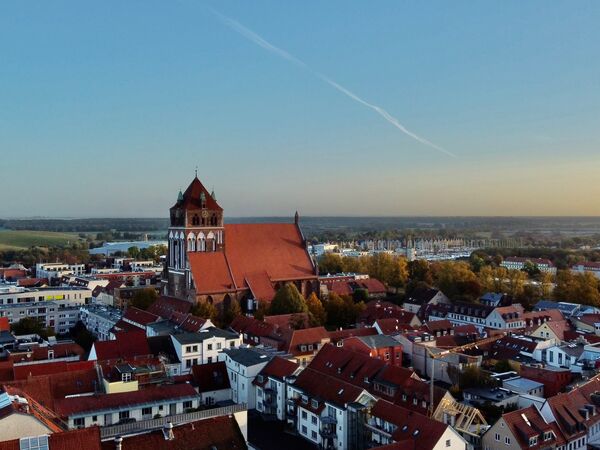
St. Mary's Church Greifswald
St. Mary's Church is a parish church in the middle of Greifswald's old town. St. Mary's Church can be visited after the Sunday service until 1 pm. The following opening hours apply in June, July and August: Monday to Friday from 10 am to 6 pm and Saturday 11 am to 3 pm. You can register for guided tours of the church at the church office or in the church.
Construction of St. Mary's Church, also known as the "Fat Marie" by the people of Greifswald, probably began in the middle of the 13th century. Together with the two other town churches, St. Nikolai and St. Jacobi, it was first mentioned in documents in 1280. The church was built as a hall church and is today one of the most impressive examples of North German Brick Gothic architecture. Worth seeing inside the church are the preserved colorful paintings (14th century), the medieval court hall, the large load-bearing treadmill in the tower, the memorial chapel, the altarpiece - a replica of Correggio's "Holy Night" and the richly decorated pulpit (16th century).
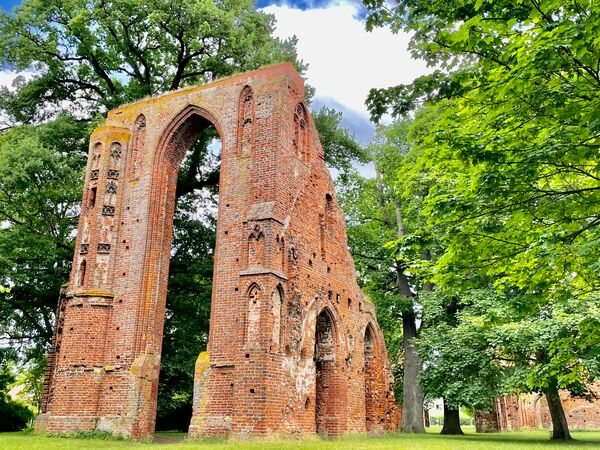
Eldena monastery ruins
The monastery ruins and park are a popular excursion destination for Greifswald residents and their guests. The monastery ruins are also the starting and finishing point of the themed cycle path "Route of North German Romanticism", which traces the stations and lives of the North German Romantics of Western Pomerania.
Caspar David Friedrich (1774-1840) made the ruins of the medieval Cistercian monastery of Eldena widely known with his paintings and drawings. The remains of the once important monastery are embedded in a park with old trees, including 180-year-old oaks, which illustrate Friedrich's ideas and characterize the romantic atmosphere of the grounds. The main accent of the ruins is the imposing west façade of the former monastery church with its high ogival window opening.
The monastery of Hilda (Eldena) was founded in 1199 after Cistercian monks were forced to abandon their monastery in Dargun as a result of armed conflict. The new monastery was built to the east of the future town of Greifswald, at the mouth of the River Ryck into the Danish Wiek. In 1248, the "oppidum Gripheswald" was first mentioned in a document among the monastery's possessions and in 1250, today's Greifswald was granted town charter. The monastery ruins are located in the Eldena district, in the immediate vicinity of the fishing village of Wieck and the Greifswald Bodden.
In the Middle Ages, Eldena was the most important monastery in the region, the economic and spiritual center of the area and reached its heyday around 1400. From the early 13th century to the beginning of the 15th century, it was structurally designed to reflect its importance. The monastery existed until the Reformation in the region in 1533 and subsequently fell into disrepair.
In 1634, the University of Greifswald received the Office of Eldena from the last Duke of Pomerania, Bogislaw XIV, and with it the monastery grounds and associated land. After plundering by imperial and Swedish troops during the Thirty Years' War, the remains of the medieval monastery complex fell into disrepair. From the second half of the 17th century, they were even used as a quarry for fortifications and university buildings in Greifswald.
The rescue of the complex is largely due to the intervention of the Prussian Crown Prince Friedrich Wilhelm (1795-1861, later King Friedrich Wilhelm IV), who was enthusiastic about romantic ideas. In 1827, he found the ruins in a dilapidated state. As a result, the first clearing and restoration work was carried out between 1828 and 1832 and a park was laid out to make the site accessible. Oak trees were planted in place of the missing nave pillars. The merging of the eternally recurring nature with the venerable architectural evidence of an irretrievably past time carries a profound symbolism that still captivates today's visitors at all times of the year and day.
Caspar David Friedrich, born in Greifswald in 1774, made the Eldena monastery ruins world-famous. He is now regarded as the most important painter and draughtsman of the early German Romantic period and used sketches of the monastery ruins as models for his paintings "Winter", "Monastery Ruins in the Giant Mountains" and "Abbey in Eichwald", among others. Some of his works are on display in the Pomeranian State Museum. In the Caspar David Friedrich Center in Greifswald's city centre, you can experience the life and work of the painter in an impressive way.
The post-Reformation history of the estate includes the expansion of the Amtsgut and the founding of an agricultural academy in 1835, which existed until 1876. The remaining monastery buildings were also used for agricultural purposes.
The monastery ruins have been owned by the University and Hanseatic City of Greifswald since 1937. Nowadays, the monastery ruins and the surrounding park are a popular local recreation area, a landmark of the town and a backdrop for filming and various events. In summer, there are regular theater performances, the Eldena Monastery Market (since 2014), the Eldena Jazz Evenings (since 1981) and other concerts and events. The monastery ruins are a stop on the Caspar David Friedrich Picture Trail and the European Route of Brick Gothic.
Parking & directions: https://www.greifswald.de/de/freizeit-kultur/veranstaltungen/maerkte/klostermarkt/anfahrt-klosterruine-eldena/
Route of North German Romanticism: Eldena monastery ruins - Friedrich's favorite motif
Caspar David Friedrich was born in Greifswald on September 5, 1774 and is considered the most important painter and draughtsman of early German Romanticism. In his paintings "Winter" and "Abbey in Eichwald", he used sketches of the ruins of Eldena Abbey as models, making them world-famous. During his visits home, Caspar David Friedrich constantly rediscovered the architecture of the monastery ruins. He drew it from all perspectives. The high west façade was of particular interest to him, as it forms the focal point of many of his works. His paintings brought the ruins into the public eye. This is the starting and finishing point of the themed cycle route "Route of North German Romanticism".
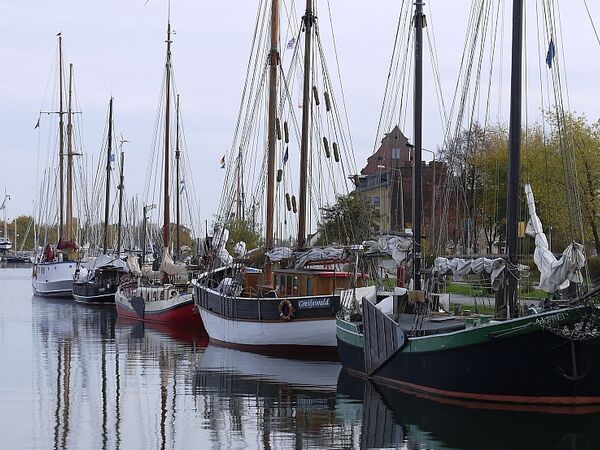
Museum harbor Greifswald
Gaff-rigged ketch and schooner, seaquat and ram ship, cruiser and dinghy - around 45 old ships characterize the image of the museum harbour in Greifswald, which was founded in 1991 based on the model of the museum harbours in Flensburg and Hamburg. This was the Hanseatic city's response to the increased interest in historic ships and traditional seamanship.
As part of the old city harbour, the museum harbour stretches from the Steinbeck Bridge to the old granary and characterizes the maritime flair of the Hanseatic city. The oldest ship that visitors can admire in the museum harbor is the Zeesboot "Pommerland" from 1880. www.museumshafen-greifswald.de lists all the ships moored here. 15 of them offer excursions and sailing trips. You can also take part in the annual gaff rigging.
By the way: The Greifswald Museum Harbour Association also organizes group tours of the museum harbour and the museum shipyard, where old ships are restored, on request.
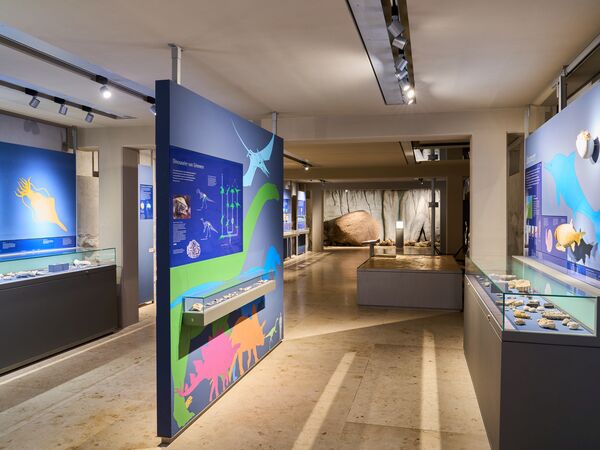
Pomeranian State Museum
History and art await you at the Pomeranian State Museum - in an award-winning ensemble of buildings that impressively combines Gothic, Classicist and contemporary architecture. The latest special exhibition "Heimatstadt" on Greifswald's famous son, the Romantic artist Caspar David Friedrich - until January 5, 2025.
The year 2025 at the Pomeranian State Museum
The permanent exhibition is open all year round - 14,000 years of Pomeranian history await you! There is also an extensive program of events with lectures, guided tours, art breaks and much more - including the anniversary "775 years of Greifswald".
Special exhibitions
A new look
In spring 2025, we will once again open our convent building and present moments from the art collection. Look forward to seeing old acquaintances such as Frans Hals and Vincent van Gogh, meet artists in new combinations and discover familiar works as well as those that have been waiting to make their appearance.
New, white ceramics from Szczecin
24.05.-31.08.2025
The aim of the cabinet exhibition is to reinterpret the craft tradition known as "Szczecin ware" in the light of contemporary artistic and cultural contexts. The works on display were created as part of ceramic workshops in which the participants set themselves the task of engaging in a creative dialog with the historical heritage.
Viking gold. Treasure policy since 1800
Traveling exhibition with digital presentation
October 2025 to January 2026
Treasures from the Viking Age (approx. 800-1100) are repeatedly found in the Baltic Sea region. It was the same even earlier. When these treasures are found, complex processes of appropriation begin: Who is allowed to keep the "Viking gold"? Where will it be displayed? Who identifies with it? Who distances themselves from it? And how do these processes change over time? The exhibition "Treasure Politics" shows that the appropriation of cultural heritage and its demarcation are politically charged.
On the way to the Gallery of Romanticism
After the big anniversary in 2024, Caspar David Friedrich remains relevant: the new Gallery of Romanticism puts the most famous Pomeranian in the spotlight permanently. The topping-out ceremony was celebrated in July 2024, so it's only a matter of time before the opening! There you will be greeted by a chapel that uses multimedia to introduce you to Friedrich's poetic imagery. You can experience how his paintings took shape, immerse yourself in the originals and find out what kind of person the soap farmer's son from Swedish Pomerania was. Or did you know that Caspar David Friedrich bred canaries and was famous and infamous for his enormous full beard?
Pomerania - Land by the sea
Take your time to discover the eventful history of the region on both sides of the Oder! From the first hunters and gatherers to the 20th century, 14,000 years of history await you - with impressive exhibits, elaborate media stations and installations. Discover exciting facts from prehistory and the Middle Ages, from Stone Age megalithic tombs, Slavic trading networks and the heyday of the Hanseatic League. Find out why Martin Luther, a Saxon princess and a Pomeranian duke gathered on the unique Croy carpet, why the Swedes completely surveyed their province of Pomerania and how fishing villages became fashionable Baltic seaside resorts. The 20th century, with its ruptures and continuities, is illuminated by objects and eyewitness accounts - from the World Wars to flight and expulsion, "East Mecklenburg" in the GDR, "West Pomerania" in Poland and the "Pomeranian Renaissance" after German reunification.
A glass road connects the buildings of the museum complex.
If you've seen a lot, you need to take a break. The Franziskaner monastery garden, the museum store and the museum restaurant "Natürlich Büttners" - Restaurant & Manufaktur invite you to take a break.
See you soon at the Pomeranian State Museum
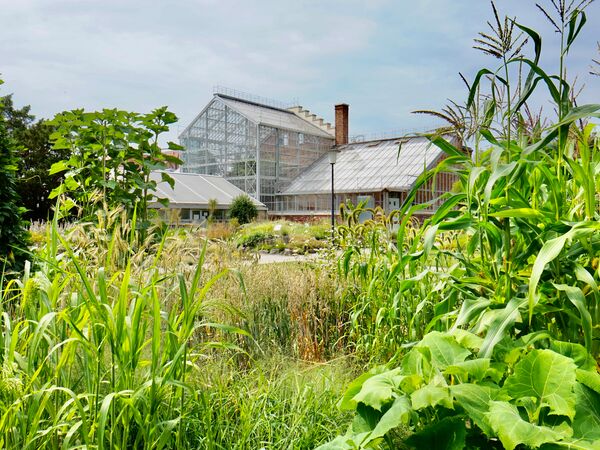
Greifswald Botanical Garden
The botanical garden was founded in 1763 and belongs to the University of Greifswald. It consists of 16 greenhouses and outdoor areas, ponds, 8000 different plant species including: Cacti, giant water lilies, tropical orchids and aromatic and medicinal plants. The construction of the new botanical garden (arboretum) began in 1934 under botany professor Paul Metzner (1893-1968) on Friedrich-Ludwig-Jahn-Straße.
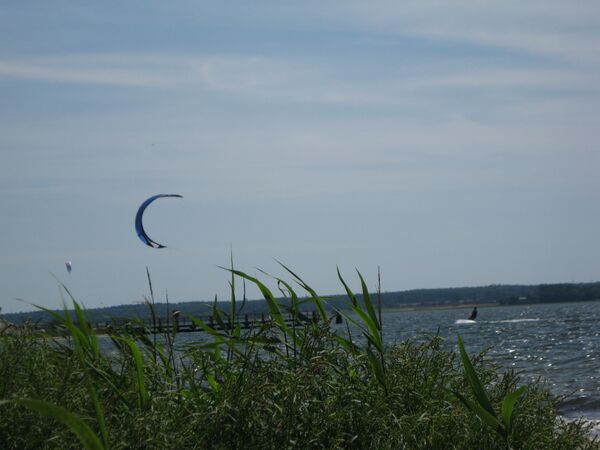
Naturstrand Ludwigsburg
Der Strand in Ludwigsburg ist ein beliebtes Ausflugsziel für Urlauber und Einheimische der Umgebung. An heißen Sommertagen findet man ein schattiges Plätzchen unter den Kiefern des Küstenwaldes und eine kleine rustikale Gaststätte bietet ein solides Angebot von Speisen und Getränken. Sehr zu empfehlen ist der selbstgebackenen Kuchen. Für Kite- und Surfbegeisterte bietet der Strand und das flache Wasser der Dänischen Wiek und des Greifswalder Boddens die beste Bedingungen.
Der Strand liegt ca. drei Kilometer außerhalb des Ortes, direkt an der Dänischen Wieck. Mit dem Fahrrad ideal zu erreichen über eine verkehrsberuhigte Straße. Der Ostseeküsten Radweg führt hier entlang. Der bewachte Parkplatz kostet zwei Euro pro Tag.
Der Strand ist sehr schön mit viel Sand und teilweisem Grasbewuchs. Von hier hat man einen herrlichen Blick über den Bodden auf die Silhouette Greifswalds und den Hafen.
Das gemütliche Restaurant mit großer Terrasse lädt zu warmer Küche und kaltem Eis ein. Von Mai bis Oktober hat dieses täglich für Sie geöffnet. In der kälteren Jahreszeit ist am Wochenende auf.
Toilettenbenutzung ist ebenfalls möglich. Für die Kleinen gibt es einen großen Spielplatz und viel Platz zum Toben.
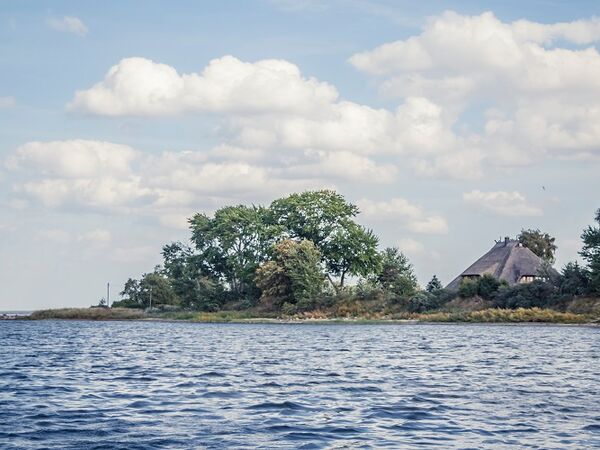
Strand in Gahlkow
Der Strand in Gahlkow ist ein beliebter Kite- und Surfspot am Greifswalder Bodden. Als beliebter Ausgangspunkt bei Windsurfern gilt der Strand in Gahlkow nahe der Bungalowsiedlung. Auch hier findet man einen schönen weitläufigen Naturstrand mit einem schmalen Sandstreifen. Das Restaurant „Boddenblick“ ist nur 200 Meter entfernt (keine öffentliche Toilette). Am Strand gibt es einen kleinen schattigen Parkplatz.
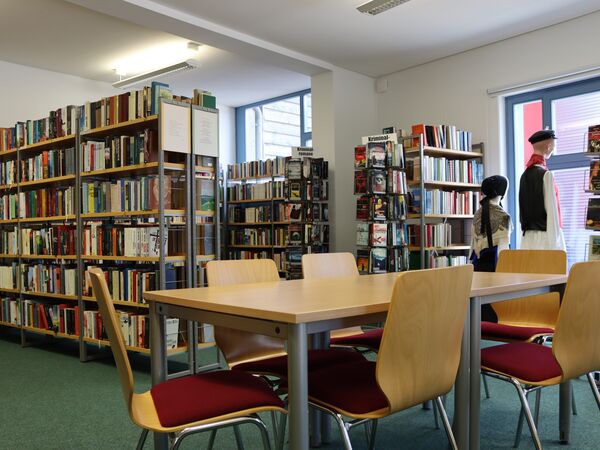
Lubmin resort administration
The seaside resort of Lubmin is an insider tip on the Greifswald Bodden at any time of year. Situated directly between pine trees, dunes and a large shallow water area with a child-friendly beach, the seaside resort offers pure nature and invites you to enjoy a peaceful and enjoyable vacation.
The extensive network of cycling and hiking trails along the Lubminer Heide promises a variety of tours for hiking, walking, jogging and horse riding in the neighboring communities and in the surrounding area of Western Pomerania. The seaside resort also offers a wide range of cultural activities. Traditional concerts in the spa gardens, sporting highlights and beach festivals delight numerous visitors and residents of Lubmin alike every year.
The seaside resort's pride and joy is its 350-metre-long pier. Centrally located between the islands of Usedom and Rügen, it is the ideal starting point for your excursion to the beautiful Baltic Sea islands. Fishing permits are available from the spa administration on presentation of a fishing license.
Spa administration opening hours:
May, June & September
Mon, Wed, Thu & Fri: 9.00 a.m. - 4.00 p.m.
Tue: 9.00 - 18.00 h
Sat: 10.00 - 13.00 h
July & August
Mon-Fri: 9.00-18.00 hrs
Sat & Sun: 10.00-14.00 hrs
October to April
Mon, Wed, Thu, Fri: 9.00 a.m. - 4.00 p.m.
Tue: 9.00 - 18.00 hrs
Easter Saturday
10.00 - 13.00
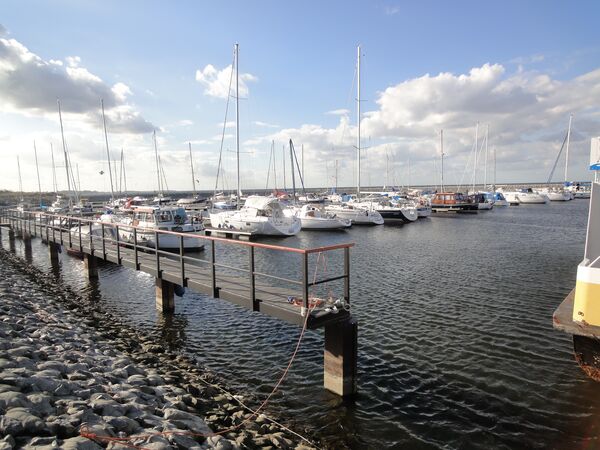
Marina Lubmin
Marina Lubmin
Lubmin Marina is located on the Greifswalder Bodden between the mouth of the Peene and Greifswald. The harbor offers direct access to a very popular sailing area, as the islands of Rügen and Usedom are easily accessible from there. Poland and the Danish island of Bornholm are also popular mooring locations.
An approximately 5 km long sandy beach, which is known as one of the most beautiful beaches on the German east coast, connects the marina with the seaside resort of Lubmin. The south coast of Rügen can be seen to the north and a nature reserve lies to the east.
A total of 180 berths are available. There is also a petrol station (diesel), various floating jetties (steel and concrete), supply columns with water, electricity and lighting, Internet access via hotspot, as well as bicycle rental, parking and a comprehensive yacht service.
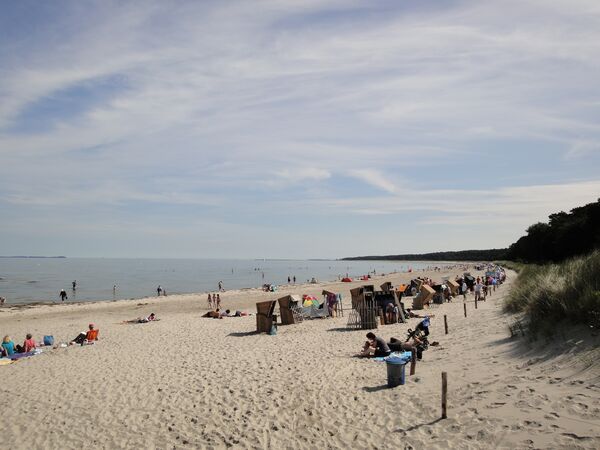
Lubmin pier
The seaside resort of Lubmin with its 350 m long pier, a wide child-friendly sandy beach and picturesque, rustic pine forests offers peace and nature as well as ideal conditions for a family vacation.
Lubmin is a real insider tip as a vacation and travel destination, and not just in summer. A five-kilometer-long beach with firm, fine-grained sand and shallow water offers ideal conditions for a vacation with small children and family. The pine forest behind the beach keeps the wind off the charming cliffs and offers a wonderful view of the pier. The surrounding area and the beach are also ideal for cycling and walking. The newly renovated, magnificent beach promenade is also a very popular destination for excursions and recreation. It is an attractive eye-catcher between the elegant old villas worth seeing, the magnificent pine forest and the endlessly long white sandy beach. Numerous hotels, vacation apartments of all categories and motorhome pitches right on the beach leave nothing to be desired. Restaurants and shops are also located close to the pier.
Route of North German Romanticism: Lubmin seaside resort - The coast in Friedrich's field of vision
The landmark of the seaside resort of Lubmin is the 350-metre-long pier extending into the Bodden. Lubmin is the only seaside resort in the Greifswald Bodden and a popular vacation destination for families. At that time, most of the town's inhabitants were farmers and there was not enough bay for beach fishing. Caspar David Friedrich made his first trip to Rügen in 1801. In his painting "View from the south coast of Rügen", he noted the Prussian side of the island alongside the villages of Wusterhusen, Wolgast and the island of Ruden, thus differentiating it from Swedish Pomerania. The seaside resort of Lubmin is not mentioned by name, although it already existed on maps at this time. This was probably due to the fact that Lubmin and Wusterhusen were on the same line of sight.
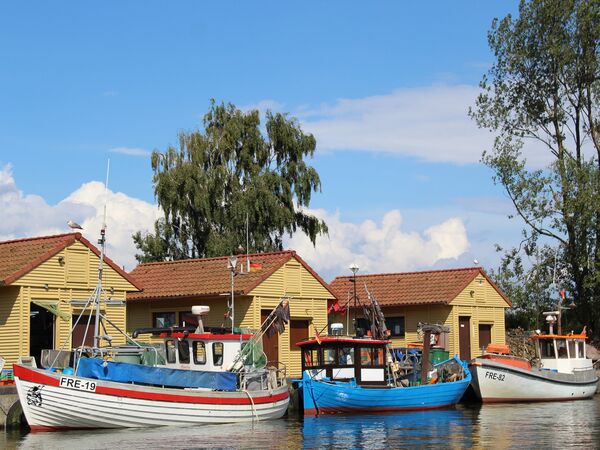
Badestrand Freest
Der Strand im Fischerdorf Freest ist zum Sonnenbaden hervorragend geeignet und hat darüber hinaus ein flaches kinderfreundliches Ufer mit einem kleinen Spielplatz. Gleich hinter der Düne ist der Fischereihafen Freest, wo es frischen und verarbeitenden Fisch gibt. Vom Matjes, Backfisch bis zur Räucherflunder ist für jeden etwas dabei.
Das Dorf Freest findet man auf dem Festland 10 km nördlich von Wolgast unweit der Mündung des Peenestroms in die Ostsee. Der Blick vom Strand auf das Mündungsgebiet und die gegenüberliegende Peenemünde kann als ein echter Genuss beschrieben werden. Der Strand ist zum Sonnenbaden hervorragend geeignet und hat darüber hinaus ein flaches kinderfreundliches Ufer mit einem kleinen Spielplatz. Hunde sind am Strand nicht erlaubt.
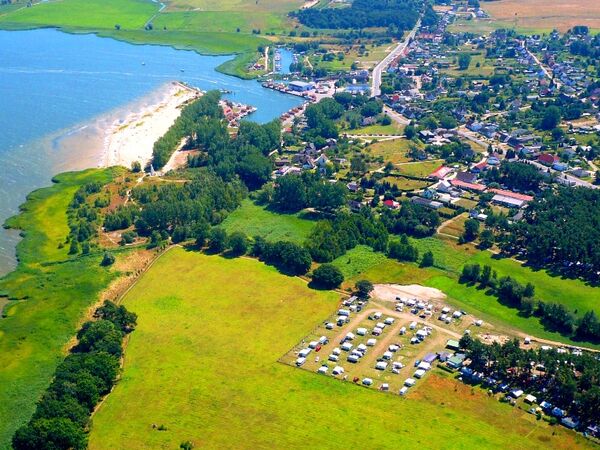
Campingplatz Waldcamp Freest
An der schönen Ostseeküste, zwischen den beliebten Urlaubinseln Usedom, und Rügen nur wenige Autominuten entfernt, befindet sich das Waldcamp Freest.
Ein kleines Paradies direkt am Peenestrom mit Blick auf die Ostsee - traumhaft gelegen in einer unvergleichlichen, naturbelassenen Boddenlandschaft. Unser Campingplatz mit seinen Ferienhäusern grenzt unmittelbar an das bestehende Naturschutzgebiet "Peenemündung" und hat ca. 45.000 m² Fläche. Der Campingplatz besteht je zur Hälfte aus einem lichten Kiefernhochwaldbestand und aus einer naturbelassenen Waldwiese, mit direktem Strandzugang, ca. 350 m.
Von Freest aus können Sie ihre Tagestouren zu den schönsten Ausflugszielen Mecklenburg-Vorpommerns, z.B. zu den Inseln: Usedom, Ruden, Greifswalder Oie und Rügen mit Wanderungen, Rad oder Schiffstouren starten. Die Usedomer Seebäder Zinnowitz, Heringsdorf oder Ahlbeck laden zum Flanieren auf den wunderschönen Promenaden ein. Vom Freester Hafen können Sie stündlich mit der Personenfähre zur Insel Usedom fahren.
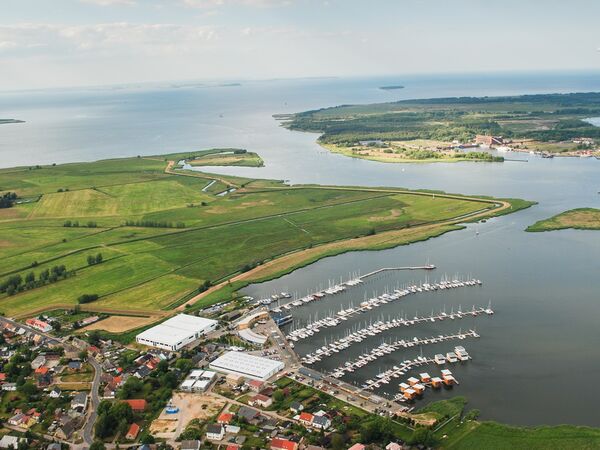
BALTIC SEA RESORT
Eingebettet in unberührter Natur, vor den Toren der schönen Insel Usedom, befindet sich die Marina Kröslin, der einzige 5-Sterne-Yachthafen der Region. Die hochmoderne Anlage bietet eine Fülle attraktiver Möglichkeiten, die einen Besuch zu einem unvergesslichen Erlebnis machen.
Die Marina Kröslin – mehr als nur ein Hafen.
Egal wohin die Reise gehen soll, ob Segeltörn, Angelausflug, Familienurlaub oder einfach nur die Suche nach Erholung am Wasser. In der Marina Kröslin können Sie Ihren Traum wahr werden lassen.
Für Wassersportler ist es der ideale Heimathafen, denn die 5-Sterne-Marina kümmert sich nicht nur leidenschaftlich um das Boot, sondern auch um die gesamte Besatzung. Für das leibliche Wohl wird im Restaurant und der nahen Tapasbar gesorgt, die kleinen Geschäfte laden zum Bummeln und Verweilen ein und ein Besuch im Friseursalon bietet den gelungenen Abschluss eines Landaufenthaltes für sturmerprobte Kapitäne.
Als Gast von der Landseite ist man ebenso herzlich willkommen. Wenn Sie möchten, betten wir Sie auf sanften Wellen in unseren Floating Houses, nehmen Sie mit aufs Wasser auf unserem Kurztrip unter Segeln oder versüßen Ihnen Ihre Freizeit in unserer Wellness- und Erholungsanlage.
Die Marina Kröslin – ein Hafen mit Wohlfühlgarantie.
Zertifiziert: Gelbe Welle, IMCI 5-Sterne
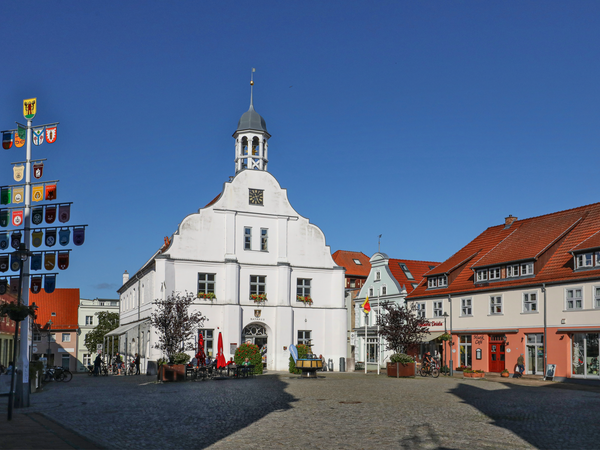
Historisches Rathaus Wolgast
Das Historische Rathaus bildet den Kern der Wolgaster Altstadt auf mittelalterlichem Grundriss. Im Rathaus befindet sich im Erdgeschoss die Touristinformation Wolgast.
Im 15. Jahrhundert erbaut fiel das Rathaus 1512, 1625 und 1713 jeweils den Stadtbränden zum Opfer und wurde 1720 bis 1724 wieder aufgebaut. Die Reste des ursprünglich gotischen Gebäudes sind noch sichtbar. Die Fassade ist allerdings aus der Zeit des Spätbarocks. Heute befinden sich im Historischen Rathaus das Standesamt und die Touristinformation. Im Kaminzimmer finden Vorträge und kulturelle Veranstaltungen statt. Einmal wöchentlich werden auf dem Rathausplatz regionale Produkte auf einem Frischemarkt angeboten.
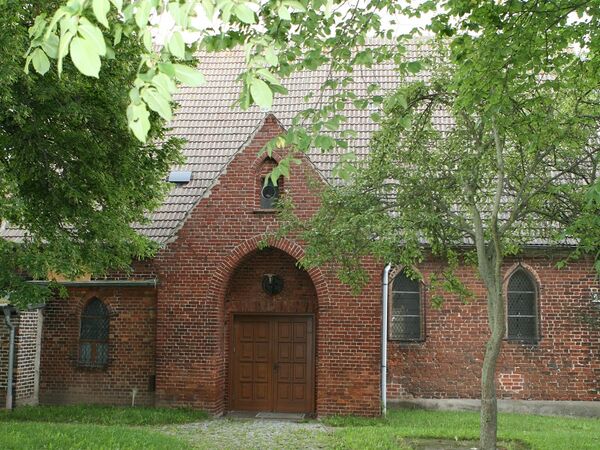
Kapelle St. Jürgen
Die St. Jürgen Kapelle in Wolgast ist ein mittelalterliches Kirchengebäude, dass erstmals 1420 urkundlich erwähnt wurde.
Die im 15. Jahrhundert erbaute St.-Jürgen-Kapelle wurde zunächst als Hospital für Arme, Kranke und Fremde und zu Beginn des 18. Jahrhunderts als Pesthaus mit dazugehörigem Friedhof genutzt. Folgenden Generationen diente sie als Armen- und Begräbniskirche. Nach dem Zweiten Weltkrieg erfolgten umfangreiche Sanierungsmaßnahmen. Heute wird die Kapelle als Winterkirche und Veranstaltungsraum genutzt.

St. Petri Kirche
Die St. Petri Kirche ist die ehemalige Hofkirche der Herzöge zu Pommern-Wolgast.
Die dreischiffige Basilika aus dem 14. Jahrhundert war Hofkirche der Herzöge zu Pommern-Wolgast. Sie wurde um 1350 zu Ehren des Apostels Petrus erbaut. An gleicher Stelle soll ursprünglich ein heidnischer Tempel gestanden haben, den Otto von Bamberg zu Zeiten der Christianisierung Pommerns zerstören ließ. Heutzutage befindet sich die Grablege der letzten Pommernherzöge in der Gruft von St. Petri und im Kirchenschiff hängt ein Bilderzyklus aus dem Mittelalter zum Totentanz. Auf den Turm der St. Petri Kirche, der zur Öffnungszeit der Kirche bestiegen werden kann, führen 184 Stufen. Von oben erstreckt sich ein wunderbarer Panoramablick über die Stadt Wolgast bis zur Insel Usedom.

Kirche Reinberg
Kirche Reinberg (Evangelische Kirchgemeinde)
Der Feld- und Backsteinbau ist aus dem 13. Jahrhundert. Sie hat einen Turm mit Holzaufsatz. Im Innern sind Wandmalereien aus dem 15. Jahrhundert und eine reichbebilderte Barockkanzel. An der Friedhofsmauer befindet sich ein 2 m hohe Sühnestein, vor der Kirche steht eine 1000-jährige Linde.
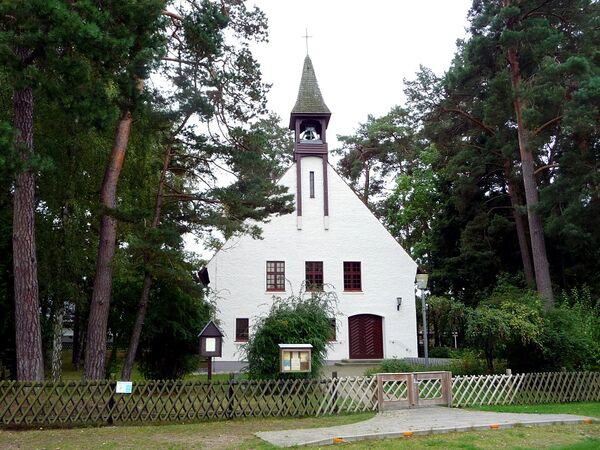
St. Peter's Church Lubmin
St. Peter's Church in Lubmin was consecrated in 1957.
The church was built between 1954 and 1957. Visits can be arranged by telephone via the parish office.

